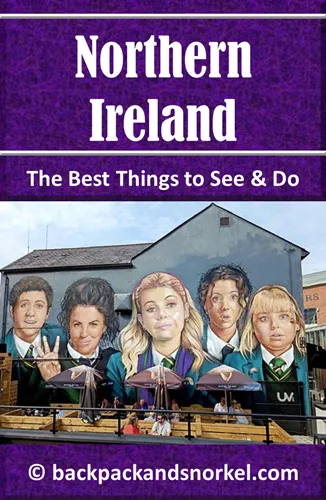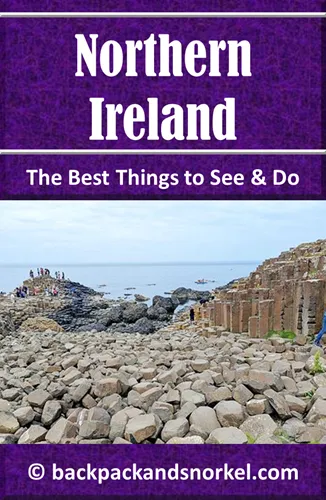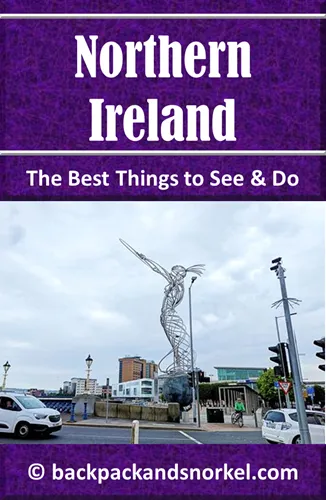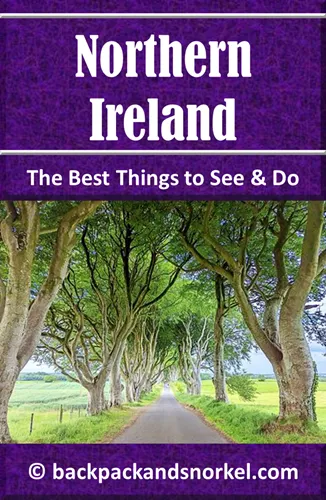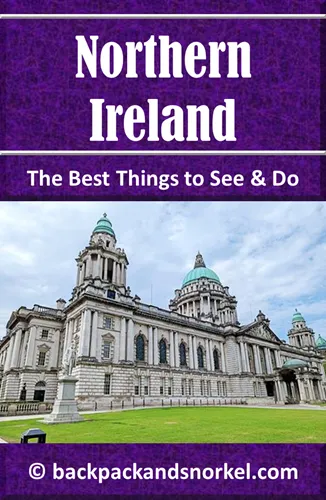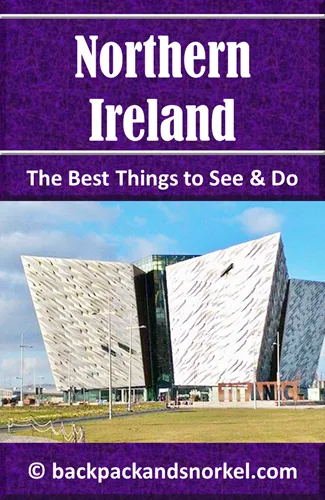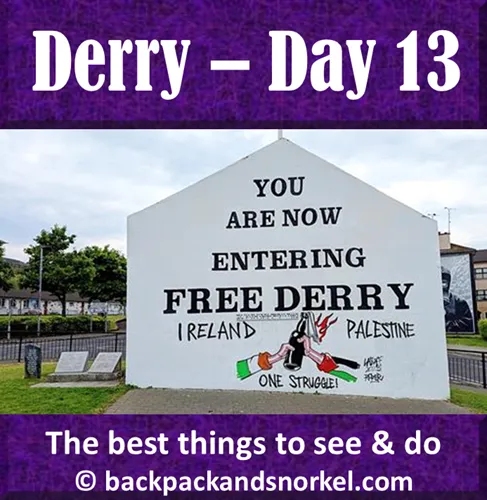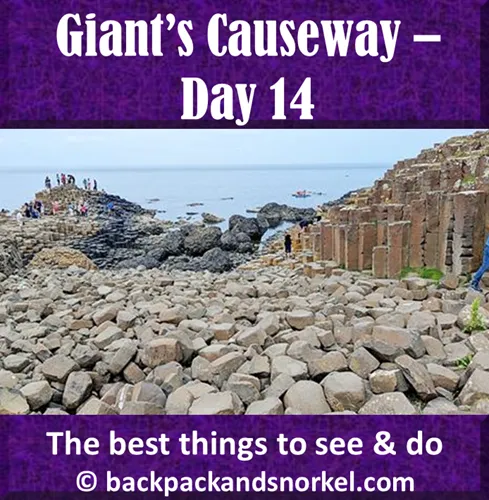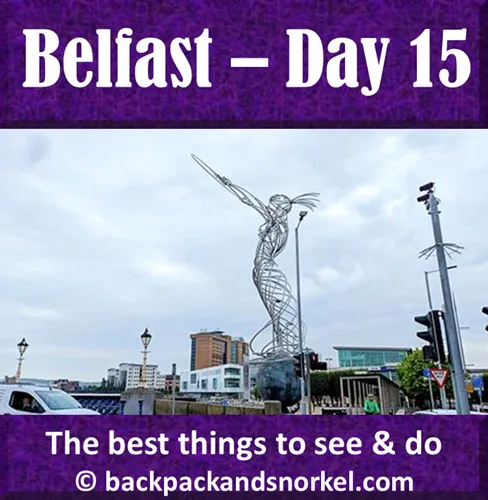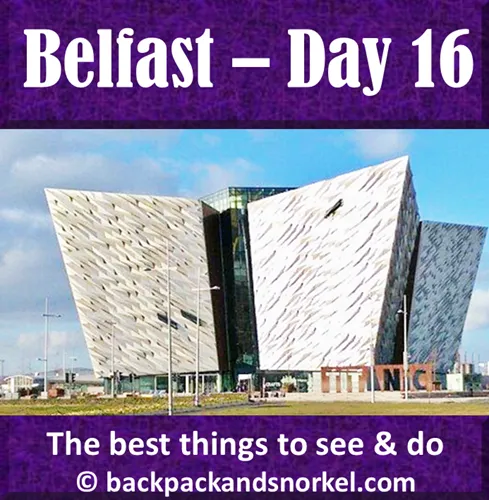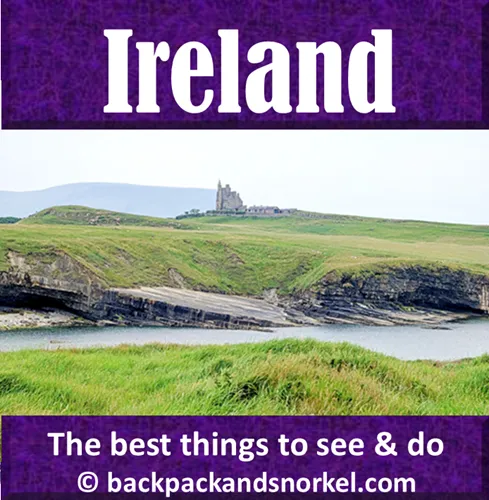Backpack and Snorkel Travel Guide for a Self-Guided City and Murals Tour of Derry - Northern Ireland Purple Travel Guide
Derry was the epicenter of The Troubles in Northern Ireland. A Self-Guided City and Murals Tour brings you to the most important locations in Derry. We provide detailed information and the best things to see and we show lots of photos so you know what you can expect.
If you follow the Ireland and Northern Ireland itinerary of our Purple Travel Guides, then you have explored the Carrowmore Megalithic Cemetery and Mullaghmore Peninsula in Ireland earlier this morning, and you have then crossed into Northern Ireland in the afternoon.
At the time of writing, there are no border patrols between Ireland and Northern Ireland at any of the many roads that connect both countries.
You may not even notice that you cross into Northern Ireland, as not every road has a sign that makes you aware of the border crossing.
The only thing that notifies you of the border crossing may be:
- Your GPS announcing ‘Welcome to Northern Ireland’ or ‘Welcome to the United Kingdom’
- The speed limit signs becoming a bit more frequent and showing smaller numbers, as Northern Ireland is part of the UK and speed limits are now in miles per hour, instead of km per hour in Ireland
- When you get out and try to pay at a gas station or restaurant, the prices are now in British Pounds instead of the Euros that are used in Ireland
This Northern Ireland Purple Travel Guide begins with the self-guided city-and-murals tour in Derry. The sights we saw in the morning in Ireland are described in our Ireland Purple Travel Guide.
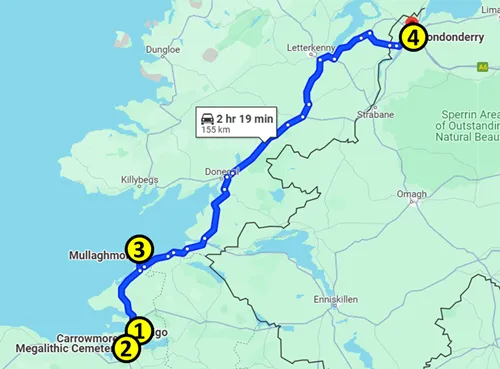
1 = Sligo
2 = Carrowmore Megalithic Cemetery
3 = Mullaghmore Peninsula
4 = (London)Derry
Here at Backpack and Snorkel Travel Guides, we typically promote self-guided walking tours.
But we realize that not everybody likes to walk by themselves in a foreign city. So, just in case that you rather go with ab guide: NO PROBLEM! Please see the tours below.
Where to stay in Derry
With a population of 85,000 people (105,000 in the urban area), Derry is the second largest city in Northern Ireland.
Derry was the epicenter of The Troubles, and the Battle of the Bogside in Derry its starting point.
Here is the accommodation that is available when you visit:
Groarty House & Manor (book)
Groarty House & Manor is a Bed & Breakfast that lies in the countryside about 2.5 miles (4.2 km) from Derry’s historic district.
You order breakfast the night before and it is then served in the breakfast room in the morning.
The rooms are clean, spacious, and typical for a Bed & Breakfast. The owners are very friendly and helpful.

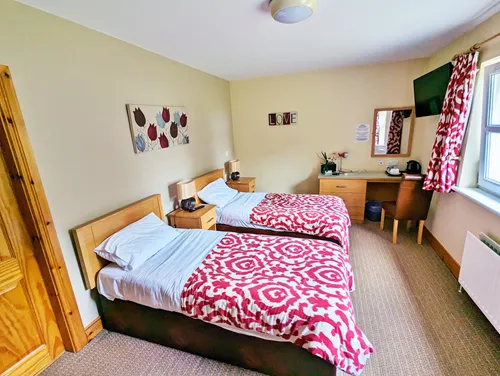
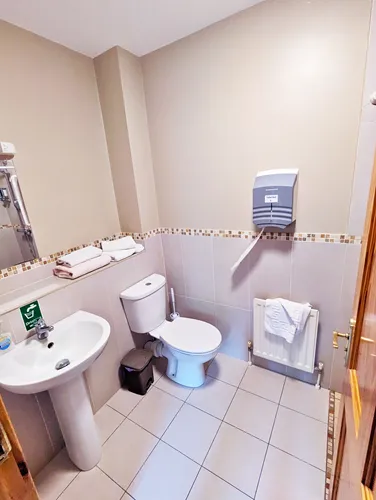
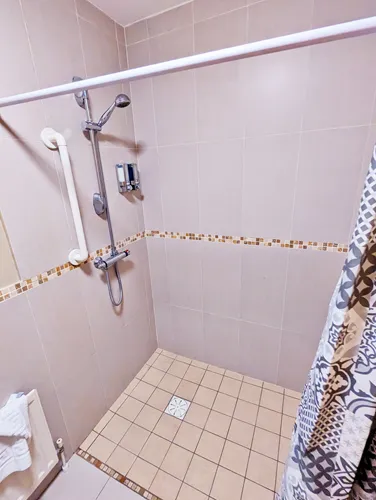
Self-guided tour of Derry
Today, Derry is the only town with a completely intact city wall in Ireland and Northern Ireland. The Walls were built from 1613 – 1619 and are about one mile (1.5 km) in circumference and have a height of 12 – 35 ft (3.7 - 10.7 m).
Through the walls lead four original gates (Bishop's Gate, Butcher Gate, Ferryquay Gate, and Shipquay Gate) and three newer gates (Castle Gate, Magazine Gate, and New Gate).
The Derry city walls were never breached, even though attackers besieged the city several times, including in 1689 when the Siege of Derry lasted 105 days, leading to the creation of the city's nickname: The Maiden City.
The area where Derry is located has a continuous recorded history since the 6th century when Saint Columba (Colmcille) founded a monastery at this site. But archeologists say that this area was inhabited before that time.
Until the 11th century, this area was mostly known for its monastic site. Over time, a village developed outside of the monastery. Its original Irish name was Daire or Doire, which was anglicized to Derry.
In 1608, the town was attacked and much of it was burned. In 1610, the west bank of the remains of town were transferred by the English Crown to The Honourable Irish Society. Under their leadership, and people and money from London, the town was rebuilt, and city walls were built from 1613 – 1619 . In 1613, the name was changed to Londonderry in honor of the London guilds who rebuilt the city. Londonderry is still the official name of the city today, even though most people just call it Derry.
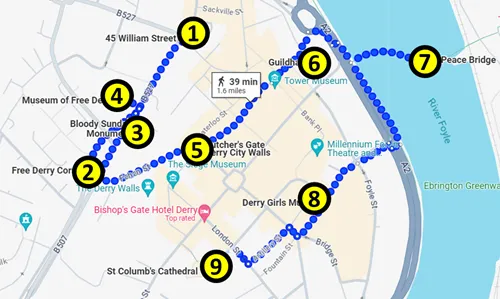
1 = Tour start
2 = Free Derry Corner
3 = Hunger Strike memorial, The People’s Monument, Bloody Sunday Obelisk Memorial
4 = Museum of Free Derry
5 = Butcher's Gate
6 = Guildhall
7 = The Peace Bridge
8 = Derry Girls Mural
9 = St Columb's Cathedral
To start your Self-Guided-Walking Tour of Derry, find a parking lot near your first destination, e.g. William Street Car Park.
Murals on Rossville Street - The People's Gallery
Start at the roundabout where William Street, Rossville Street and Little James Street intersect and walk south on Rossville Street. You will see colorful murals while you walk. End this murals walk at the Free Derry Corner.
To better understand the murals, their importance, and their backstory, we encourage you to read up on The Battle of the Bogside, Bloody Sunday / Bogside Massacre and The Troubles.
The following descriptions of The Battle of the Bogside, Bloody Sunday / Bogside Massacre are very brief and we like to encourage you to read specialized literature about this defining time in Northern Ireland history.
The Peace Mural (2004), painted by the Bogside Artists (brothers Tom and William Kelly, and Kevin Hasson).
The dove, a symbol of peace, emerges from an oak leaf, which is a symbol of Derry. Derry comes from the Irish word Doire, which means oak wood. Derry is located in County Derry and the county's nickname is Oak-Leaf county.
Each square has equal size, representing the equality of all citizens.
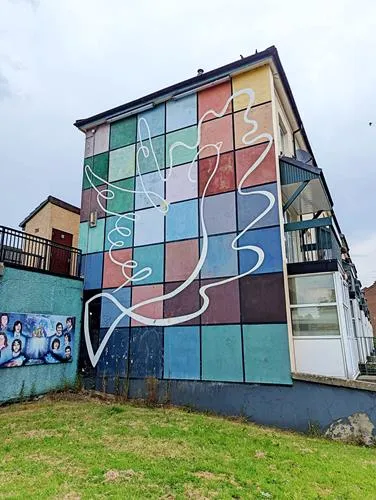
Mothers and sisters
Peggy O’Hara was the mother of hunger striker Patsy O’Hara. The little girl is pointing towards the dove in the Peace Mural on another building.
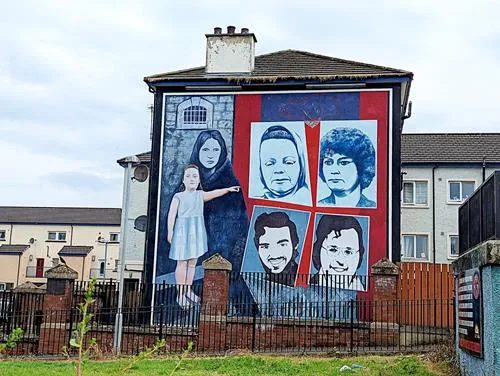
A Tribute to John Hume (2008), painted by the Bogside Artists (brothers Tom and William Kelly, and Kevin Hasson).
The mural shows four Nobel Peace Prize laureates who were primarily champions of the little people:
- John Hume, an Irish nationalist politician in Northern Ireland
- Dr Martin Luther King Jr. Hume cited him during the unveiling as the man who influenced him most during his campaign for democratic rights for the oppressed Catholics of the north of Ireland
- Mother Theresa, who was educated in Dublin and was involved in the quest for peace in the north
- Nelson Mandela, whose fight for justice in South Africa ran parallel to the fight for justice on Northern Ireland
- Brooklyn Bridge as a metaphor as all four have been bridge builders, three of them politically and Mother Theresa spiritually
William Kelly (Bogside Artists): "In art as in life, there are the contenders and the pretenders. John Hume is a contender. There is genuine achievement and mere celebrity. John Hume belongs to the former and his legacy will live long after him." Tom then read out a statement from Bono of pop-group U2 fame: "We have one rule here at U2. Whatever John Hume wants, the answer is 'Yes'. As Dr King's visionary leadership changed the United States, so did this man for the people of Ireland."
The unveiling received massive media attention. For the artists it is, 'the signature of The People's Gallery and a tribute to a great man that was long overdue.'
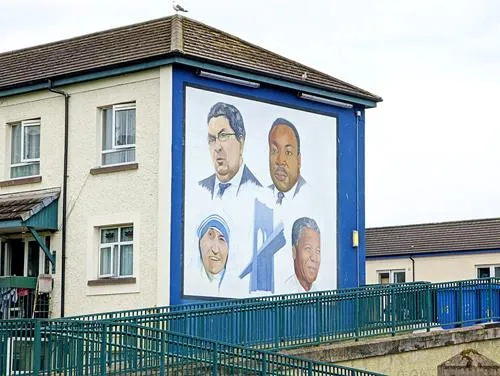
The Civil Rights Mural (2004), painted by the Bogside Artists (brothers Tom and William Kelly, and Kevin Hasson).
William Kelly (Bogside Artists): 'This mural commemorates the beginning of the struggle in Derry for democratic rights. It cannot be stressed too often that this struggle involved Protestants as well as Catholics. The 5th October 1968 march ended in bloodshed in Duke Street Derry when the RUC ran amok beating up on protesters with all the hostility and abandon of a group of Stormtroopers. The event was captured by television crews and sent shock waves throughout the civilized world. Our mural shows a typical march of the period. Our intention was to describe it as it was, a happy, almost festive occasion conducted by people who were content that they were standing up, at long last, against prolonged injustice. These early marches were inspired by the civil disobedience campaigns of Martin Luther King.'
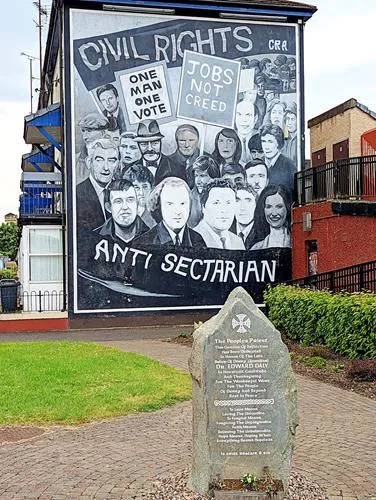
The Saturday Matinee/The Rioter (2001), painted by the Bogside Artists (brothers Tom and William Kelly, and Kevin Hasson).
The scene depicted is typical of many riots that happened in the Bogside from 1969 through the early 1970s. The riots were commonplace with many happening on Saturday afternoons hence the title 'The Saturday Matinee'.

Operation Motorman/ The Summer Invasion (2001) and The Runner (2006), painted by the Bogside Artists (brothers Tom and William Kelly, and Kevin Hasson).
The mural Operation Motorman shows an event during Operation Motorman when the British Army reclaimed no-go areas set up by republican paramilitaries in towns across Northern Ireland, including Derry, on July 31, 1972.
The Runner mural is dedicated to the memory and heroism of Patrick Walsh.
William Kelly (Bogside Artists): The mural depicts a very typical sight from the troubles. Tear gas was used extensively in riot situations. This image shows a young boy in full flight, seconds after a canister of CS gas has been fired. It complements the mural of the soldier on the adjoining wall, relating to Operation Motorman, which took place mainly in the Creggan area of the city. Beneath are two small portraits of Manus Deery and Charles Love (who also has a plaque dedicated to him). Both of these youngsters met their deaths during the troubles. The artists intended this mural to be a cautionary reminder to the young of the dangers inherent in civil conflict. It is chronologically the last mural, completed by the artists in July 2006.'
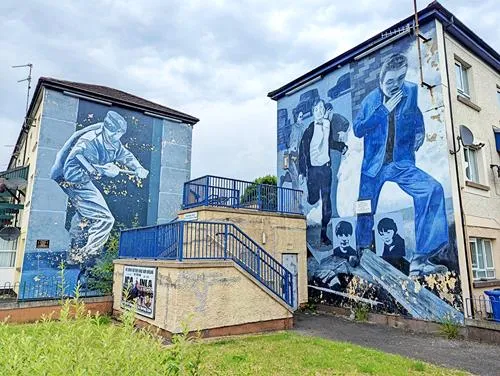
Che Guevara mural, painted (probably) by Damian “DeeDee” Walker
Ernesto Guevara Lynch, Che Guevara’s father and descended from Patrick Lynch, who emigrated from Galway (likely in 1742) and married in Buenos Aries in 1749, once declared that the blood of Irish rebels ran through his son, in reference to their Irish ancestry. He was proud of his Irish roots and how his family built a business in Argentina after fleeing Ireland.
The Irish inscription, “Thocfadh an réabhlóideach a mharú ach ní an réabhlóid a scríosadh”, means “The revolutionary may die, but the revolution lives on”.

Innocent (2023), painted by Johnny McKerr
The mural shows the portraits of all victims of the Bogside Massacre, but highlights Gerald Donaghey (17) as the only one who was not completely exonerated by the 2010 report, as he was the only one who was in possession of nail bombs.
The mural was unveiled on the day of the 13th anniversary of the publication of the report into the killings.
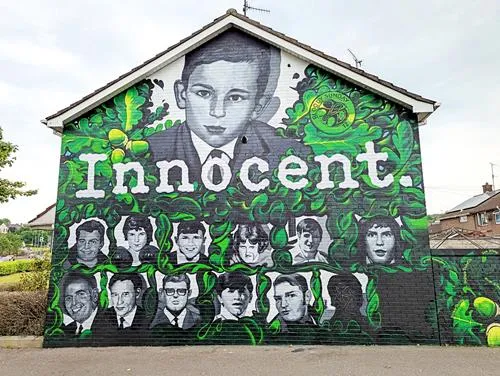
Bloody Sunday Mural (1997), painted by the Bogside Artists (brothers Tom and William Kelly, and Kevin Hasson).
The mural shows local Catholic priest (later to become Bishop Daly) leading a group of men who were carrying the body of Jack (Jackie) Duddy from the scene of the shooting. In the background are the marchers carrying a Civil Rights banner. The banner is also shown in the foreground, but bloodstained after it was used to cover the body of one of the killed persons.
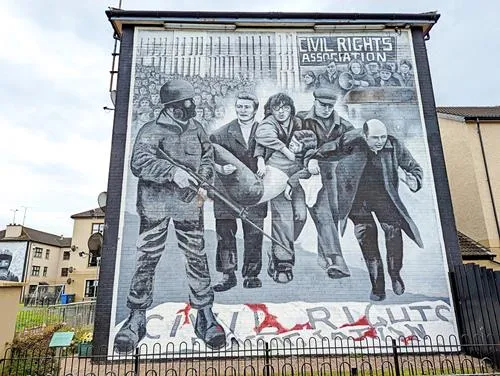
The Petrol Bomber (1994), painted by the Bogside Artists (brothers Tom and William Kelly, and Kevin Hasson).
The mural shows a scene from the Battle of the Bogside, where a young boy wearing a gas holds a petrol (gasoline) bomb.
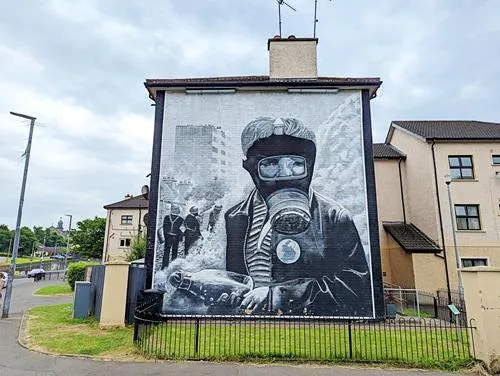
Bernadette / Battle of the Bogside
This mural shows Bernadette McAliskey, a social republican activist, addressing a crowd. She was sentenced to prison for initiating and participating in a riot.
Bernadette was later elected to parliament at the age of 21.

Battle of the Bogside
In 1961, about 2/3 of Derry’s population was catholic and 1/3 protestant. Most Catholics favored unification with Ireland while most protestants were loyal to the UK. Through gerrymandering, Derry and the rest of Northern Ireland was ruled by the Ulster Unionist Party, which was loyal to the UK, since 1925. Catholics were not just suppressed politically, but also economically.
Tensions in Derry had been building for years, and especially since 1968, before they boiled over and resulted in the Battle of the Bogside from August 12 – 14, 1969.
Bogside is a neighborhood just outside and below the city walls of Derry, where mostly Catholics live.
What happened was that the Protestant loyalist Apprentice Boys held their annual parade on August 12 to commemorates the relief of the Siege of Derry, which they celebrated as a Protestant victory and used it as a calculated insult to the Derry Catholics.
During their parade, pennies were thrown by them from the top of the walls on Catholic Bogside residents, who used slingshots to fire marbles back. When the parade passed the perimeter of the Bogside, Catholics hurled stones and nails, and an intense confrontation started.
Things got worse, when the Royal Ulster Constabulary (RUC) selectively pushed Catholic protesters back and loyalists attacked Catholic homes – later in the day, tear gas was used against Bogside residents.
Thousands of Bogside residents defended Bogside with a hail of stones and gasoline bombs, built barricades, and set up first aid stations.
On August 14, firearms were used against Bogside and at 5pm, British military got involved upon the request of the Irish government. The British troops tried to restore order and did not enter Bogside - which became a no-go area called Free Derry.
At first, the British troops were welcomed by the Bogside residents as a neutral force, but this did not last long as The Troubles got worse.
On the three days of the Bogside Riots, more 1,000 people were injured, but no one was killed.
Riots did, however, quickly spread to Belfast and became deadly – 10 people died, 745 (some say more than 1,000) were injured, of which 154 suffered gunshot wounds.
The Troubles got much worse and lasted until the 1990s.
Bloody Sunday / Bogside Massacre
Another important event that took place at Bogside was Bloody Sunday, also called the Bogside Massacre.
On January 30, 1972, a march of about 10,000 - 15,000 demonstrators, organized by the Northern Ireland Civil Rights Association (NICRA) got underway along William Street. Authorities had previously authorized the march within Bogside, but disallowed it from reaching Guildhall Square as planned.
The British Army set up barriers to prevent demonstrators from reaching Guildhall Square. In response, the organizers redirected the demonstration along Rossville Street with the goal to hold their rally at the Free Derry Corner instead.
Some demonstrators started throwing stones at the soldiers behind the barriers. The soldiers used tear gas and water cannons to defend themselves and fired rubber bullets at the violent demonstrators. As bad as it sounds, such clashes were common during those days, and observers said that these clashes were no more violent than usual.
At one point, demonstrators saw paratroopers watching them from a derelict three-story building overlooking William Street. These paratroopers were a unit that had previously been involved in extremely brutal attacks on demonstrators.
Demonstrators started throwing stones up at the windows and paratroopers opened fire, hitting two unarmed civilians, one not even participating in the demonstration.
The paratroopers were then ordered to arrest the violent rioters but not to enter Bogside Rossville Street). The local commanding officer on the ground, Lt Col Wilford, disobeyed his orders and sent his paratroopers in armored vehicles and on foot to chase people down Rossville Street, into the Bogside, cornering and shooting them. No warnings were given before soldiers opened fire. In total, paratroopers shot 26 people -13 died the same day and one died of his injuries four months later.
Months later, Lt Col Wilford’s paratroopers used excessive violence and continued their killing spree in Belfast.
As a result, Lt Col Wilford was honored by being appointed an Officer of the Order of the British Empire (OBE) and a committee that was formed to investigate Bloody Sunday whitewashed his and his paratroopers’ actions, by making up claims that demonstrators were armed.
It took until 1998, when Prime Minister Blair agreed to hold a public inquiry into Bloody Sunday. This became the biggest investigation in British legal history, took 12 years, cost about £195 million and interviewed over 900 witnesses.
British Prime Minister Cameron said when reporting on the findings in 2010:
- Mr. Speaker, I am deeply patriotic. I never want to believe anything bad about our country. I never want to call into question the behavior of our soldiers and our army, who I believe to be the finest in the world. And I have seen for myself the very difficult and dangerous circumstances in which we ask our soldiers to serve. But the conclusions of this report are absolutely clear. There is no doubt, there is nothing equivocal, there are no ambiguities. What happened on Bloody Sunday was both unjustified and unjustifiable. It was wrong.
He acknowledged that all those who died were unarmed when they were killed and that a British soldier had fired the first shots at civilians. He also said that this was not premeditated, though 'there was no point in trying to soften or equivocate' as 'what happened should never, ever have happened'. Cameron apologized on behalf of the British Government, saying he was 'deeply sorry'.
We encourage you to read up on this topic for a broader understanding, or to join a guided tour in Derry, and to visit the Museum of Free Derry.
Free Derry Corner
On January 5, 1969, someone painted “You are now entering Free Derry” graffiti on a gable wall at the end of a town house complex. This was in reference to the self-declared autonomous nationalist area in Derry’s Bogside that existed from 1969 – 1972.
The townhouse complex does not exist anymore, but the gable wall was preserved. The area where it now stands is called the Free Derry Corner.
You may have seen different pictures of the wall. This is, because the wall is occasionally freshly repainted with new pictures, but the expression “You are now entering Free Derry” is always on it.
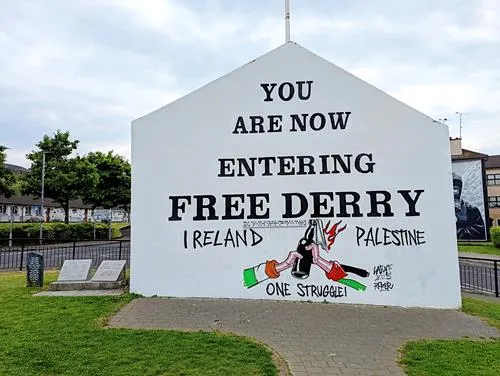
Hunger Strike memorial
Shortly before you reached the Free Derry Corner, you passed three monuments:
The Hunger Strike memorial commemorates the hunger strikes by Irish republican prisoners after the British government withdrew Special Category Status (prisoner of war rather than criminal status) for convicted paramilitary prisoners.
- 1980: Seven prisoners, later joined by others, participated in the first hunger strike. It ended after 53 days, when the British the government appeared to concede to the essence of the prisoners' five demands
- 1981: Showdown between the prisoners and British Prime Minister Thatcher after the British government did not abide bey their concession of the five demands from 1980 - the strike ended after 10 prisoners had starved themselves to death

The People’s Monument
Unveiled in 2022, this memorial is dedicated to the Derry Brigade IRA.
In contains a roll of honor with 42 names. The names on the left naturally deceased activists, and on the right are the names deceased 20th century hunger strikers.

Bloody Sunday Obelisk Memorial
This obelisk commemorates the victims of the Bloody Sunday / Bogside Massacre in 1972.
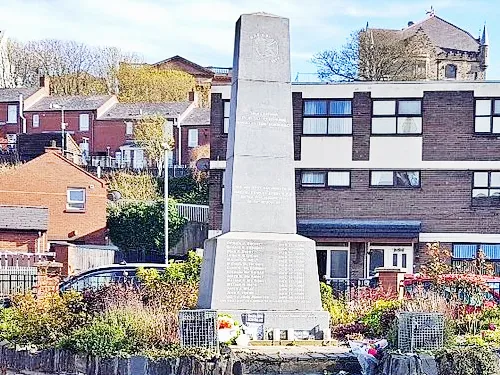
Museum of Free Derry
The comparably small Museum of Free Derry, opened in 2007, tells the story of the predominantly working-class community Bogside during the Free Derry period 1968 – 1972.
It includes the civil rights era, Battle of the Bogside, Internment, Bloody Sunday, and Operation Motorman.
At the time of writing, the opening hours are:
Mon – Sat: 10am – 4pm
Sun: 10am – 4pm (Jun – Oct)
Bank Holidays: 10am – 4pm
Closed: Christmas & New Year
Admission is £8 per adult.
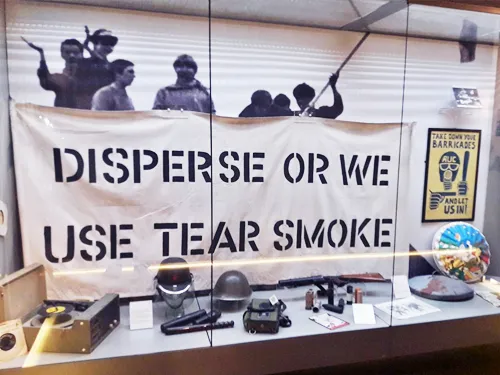

The Derry Walls
Today, Derry is the only town with a completely intact city wall in Ireland and Northern Ireland. The Walls were built from 1613 – 1619 and are about one mile (1.5 km) in circumference and have a height of 12 – 35 ft (3.7 - 10.7 m).
Through the walls lead four original gates (Bishop's Gate, Butcher Gate, Ferryquay Gate, and Shipquay Gate) and three newer gates (Castle Gate, Magazine Gate, and New Gate).
The Derry city walls were never breached, even though attackers besieged the city several times, including in 1689 when the Siege of Derry lasted 105 days, leading to the creation of the city's nickname: The Maiden City.
From the Museum of Free Derry you can either walk up the hill on the pedestrian path to the city wall, or walk along Fahan Street, which will bring you to Butcher's Gate, one of the four original gates. At the gate, you can walk up on top of the wall and walk on the wall towards the north.
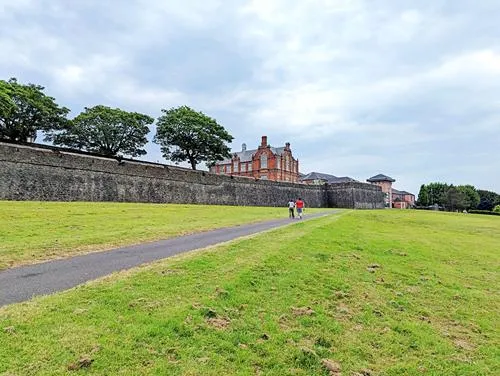
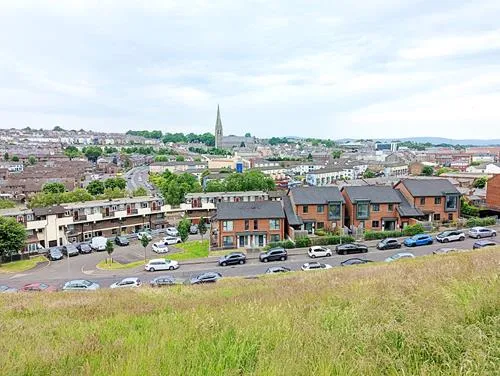
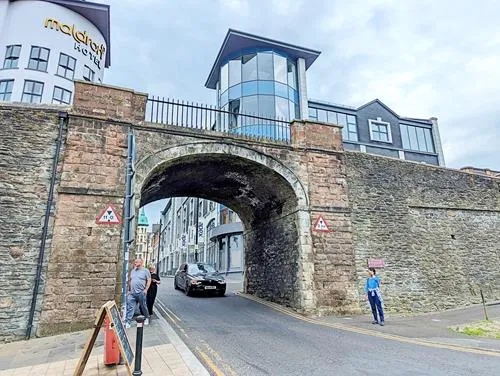
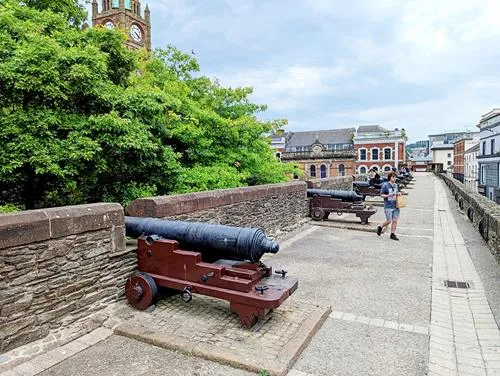
Guildhall
After the City wall makes a 90-degree right turn, you will see Guildhall. Walk a little farther to the right and you will see stairs going down to the street level. There, you can exit the walled city through Shipquay Gate and walk over to Guildhall.
The Guildhall is the meeting place of the Derry City and Strabane District Council.
The original town hall (Market House) was built in the 17th century and destroyed in the Siege of Derry in 1689.
It took until that a new town hall was built in 1890 – its clock tower was designed like the Elizabeth Tower in London.
In 1908, a disastrous fire destroyed all but the tower and rear block, and repairs took until 1912 to finish.
In 1972, during The Troubles, the building was severely damaged by two bomb explosions. Repairs took until 1977.
In 1995, US President Bill Clinton gave a speech on the square in front of the Guildhall.
At the time of writing, Guildhall is open to the public:
Mon – Fri: 9am – 8pm (last admission 7pm)
Sat – Sun: 9am – 6pm (last admission 5pm)
Admission is free, but you can book a guided tour for £2 per person.

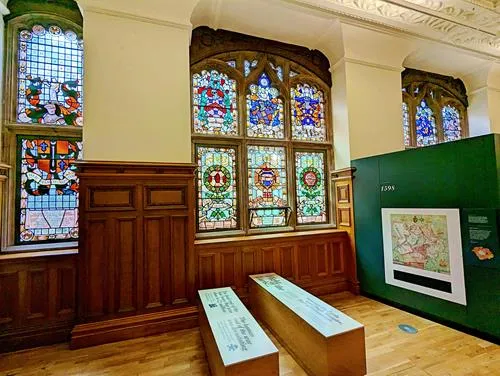
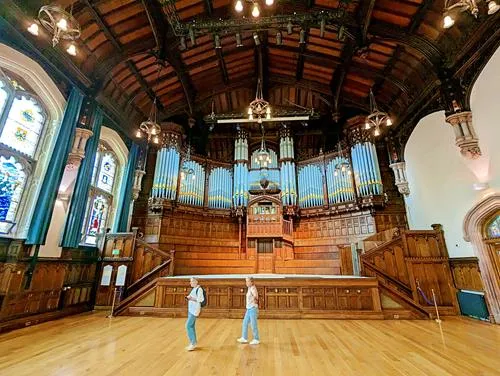
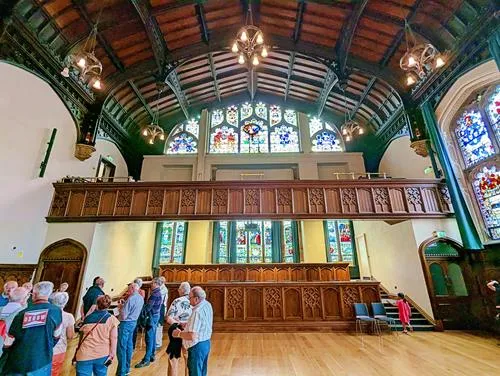
Peace Bridge
The Peace Bridge is a 771 ft (235 m) pedestrian and bicycle bridge across the River Foyle. It opened in 2011 and connects the mostly unionist Waterside on the east bank of the river with the predominantly nationalist Cityside on the west bank.
As the name suggests, the bridge is intended to improve relations between both sides.
The bridge has an asymmetrical shape that is composed of two identical sides that are supported by two sloping pillars. The design is a symbolic outreach to the two communities to peacefully come together.
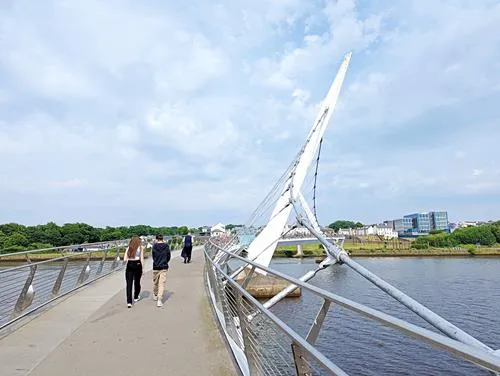
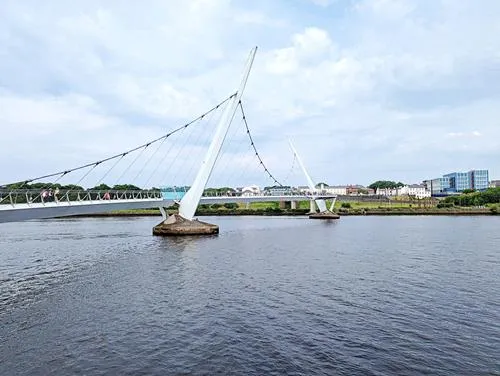
Derry Girls Mural
The Derry Girls was a British teen sitcom that ran from 2018 for three series. It followed Erin Quinn, her cousin Orla, and their friends Clare, Michelle, and Michelle's English cousin James through their teenage years during the end of the Troubles in Derry.
The five attend a Catholic girls' secondary school, and they frequently find themselves in absurd situations. Even though the plot lines are fictional, they reference actual events of The Troubles.
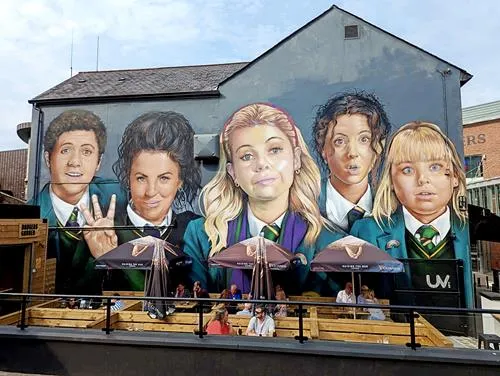
Close to the mural is Foyleside Shopping Centre in case you want to do a little shopping.
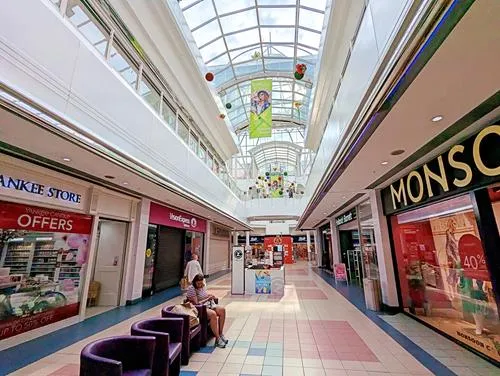
St Columb's Cathedral
St Columb's Cathedral is the cathedral church and episcopal see of the Church of Ireland's Diocese of Derry and Raphoe.
It is dedicated to Saint Columba (Colmcille), the patron saint of Derry. Columba (521 –597 AD) was an Irish abbot and missionary evangelist who established a Christian settlement in the Derry area, and then went on to spread Christianity to, what is now, Scotland.
The church construction started in 1628, and consecration was in 1633.
Stones from local quarries were used and the building style is called: Planter's Gothic.
Parts of its exterior and interior were remodeled over the years, including:
- a complete remodel of the interior from 1861-1862
- the addition of the chancel in 1887, on the foundations that had been laid in 1633 and were discovered during foundation work for the new chancel, which completed the cathedral
- the construction of the Chapter House in 1910
The cathedral is typically open for visitors from 10am – 3pm from early April – late September and until 4pm in August.

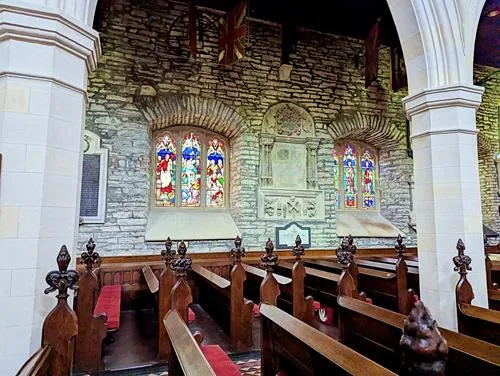

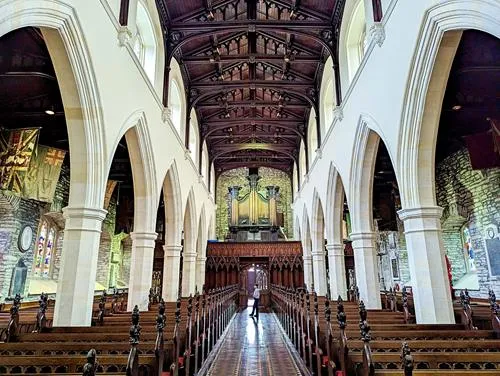
Where do you want to go now?
Author: Rudy at Backpack and Snorkel
Bio: Owner of Backpack and Snorkel Travel Guides. We create in-depth guides to help you plan unforgettable vacations around the world.
Other popular Purple Travel Guides you may be interested in:
Like this Backpack and Snorkel Purple Travel Guide? Pin these for later:
